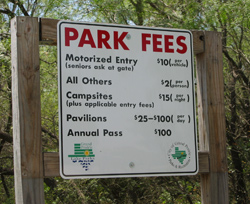 And just what has suddenly become “the hottest topic in parks and recreation,” you ask?
And just what has suddenly become “the hottest topic in parks and recreation,” you ask?
It’s fees and charges. No question about it—fees and charges.
The subject is on everyone’s mind as budget woes for parks and recreation agencies deepen. Systems of every size from the smallest to the largest—from Massachusetts to California--are in a desperate search for new sources of revenue. And one of the most reliable (and sometimes only) short-term fixes is to raise fees.
Developing long-term sustainable new revenue sources for parks and recreation is still a viable proposition and there are some sparkling examples to point to from cities and counties and states around the country—but it takes a long time to build partnerships, secure grants, and leverage private sector funds for new sources of revenue. For park and recreation agencies coping with annual double-digit budget cuts while trying to maintain services and programs, raising fees and charges is often the only immediate practical option.
Establishing the need for fees and setting them at reasonable price points is part and parcel of the business of public parks and recreation. The rationale for charging fees (and against charging them) can be found with clarity and detail in Chapter 19 of the profession’s “bible”: Management of Park and Recreation Agencies, 3rd edition (M. Moisechek, editor).
The searing reality for most park and recreation agencies—a reality that has developed just in the past two years, is that park and recreation agencies must raise their fees and charges, and in some cases, to the maximum that the market will bear. The stark alternative is often to simply stop providing those programs and services.
Over the past year, I have found it difficult to find an agency this year that has not already raised fees or made plans to do so soon. Across the country, agencies are grappling with how to raise fees in reasonable increments without inflaming public opinion. And how to meet their revenue requirements without pricing traditional recreational experiences out of sight for regular families and users.
Thinking more entrepreneurially is not a bad thing, and in fact it is part of the “new normal” for park and recreation administrators and managers. A new willingness on the part of administrators to look at revenue-producing ideas can stimulate creative public/private partnerships, improve opportunities for local business development, and even add entirely new services and amenities to parks and facilities.
But deeper, more fundamental issues coming to the forefront in this debate touch the core mission of public parks and recreation. Will our public park and recreation systems become “pay-to-play” recreation resources that serve only those who can afford to pay? Will those who can pay be the only ones who will be able to use and enjoy park facilities and programs? Will only traditional recreation programs be capable of turning a profit? Will agencies be able to maintain a good balance of programs, services, and experiences for the public that remain free? What about nature centers and historic and cultural parks—what will happen to them, for surely they cannot turn a profit even in the best of times? Will unforeseen consequences result from a rush to raise fees? Consequences such as a loss of recreation immunity in the event of accident or injury—or worse, a loss of public support due to widespread regard of park and recreation services as profit-driven commercial enterprises?
Of course, fees and charges are a reality—a practice that is economically necessary no matter how valid some of the philosophical and legal concerns may be. And it’s worth examining how park and recreation agencies are implementing them at their facilities and in their programming.
Part Two of this series explores the fees and charges landscape with various real-life examples from several very different agencies. Stay tuned…
Richard J. Dolesh is NRPA’s Chief of Public Policy.

